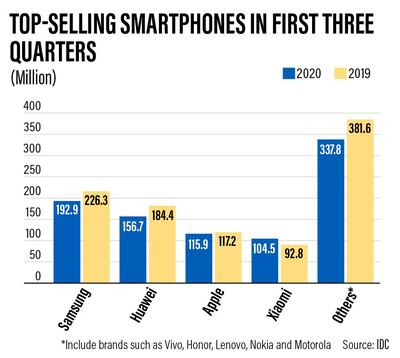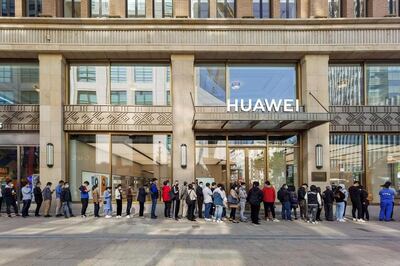Global smartphone industry, which suffered three consecutive quarterly declines this year due to the coronavirus-induced market disruptions, is expected to return to growth in 2021, driven by the deployment of 5G networks and availability of more affordable handsets, industry analysts said.
In developed markets, 5G will be available to most consumers regardless of brand or price point, Ryan Reith, vice president at Massachusetts-based International Data Corporation, said.
“Marketing has ramped up significantly. Products are widely available. Promotions are happening ... and it is clear that the top sales initiative in these markets is to push 5G,” Mr Reith added.
Like other sectors, the pandemic upended the smartphone industry and handset sales as it led to wide-spread store closures and disrupted supply chains.
But the smartphone vendors and retailers soon adapted, transitioning their business to online channels as the Covid-19 confined people to their homes.
"Despite the negative impact of Covid-19 felt across the phone industry in 2020, vendors and channel partners have learned new ways to attract buyers during this difficult time," said Anthony Scarsella, research manager at IDC.
South Korean electronics giant Samsung sold 192.9 million smartphones in the nine months up to September 30, about 33.4 million less than a year ago, with its market share at 21.2 per cent, according to IDC.
Chinese manufacturer Huawei sold 156.7 million handsets during the same period and had a 17.2 per cent market share.
In the first three quarters of the year, Apple and Chinese smartphone maker Xiaomi grabbed 12.8 per cent and 11.5 per cent market share, respectively.
Apple, which usually launches new iPhones every year in the third quarter, was forced to push this year’s release to October owing to coronavirus-related supply chain disruptions.
This led to a sharp decline in the third quarter sales. However, analysts expect it to bounce back in the holiday quarter as it capitalises on strong, early demand for the new iPhones and robust trade-in offers by major telecoms networks, especially in the US.
Early signs of a recovery were also seen in a few markets during the third quarter, including in parts of Asia-Pacific and Latin America, according to Connecticut-based research and advisory firm Gartner.
“Near normal conditions in China improved smartphone production to fill in the supply gap in the third quarter which benefited sales to some extent,” said Anshul Gupta, senior research director at Gartner.
“For the first time this year, smartphone sales to end users in three of the top five markets, India, Indonesia and Brazil increased [in Q3], growing 9.3 per cent, 8.5 per cent and 3.3 per cent, respectively.”
IDC added that a “faster than expected rebound” in key emerging markets could further boost the smart phone sales. India, which is the second largest market globally, witnessed very strong volumes during the third quarter despite further concerns around the Covid-19 pandemic.
“Global smartphone sales experienced moderate growth from the second quarter of 2020 to the third quarter. This was due to pent-up demand from previous quarters,” Mr Gupta said.
But certain challenges still persist. Gartner said that the pandemic-induced delays in 5G network upgrades has “limited the opportunity for smartphone vendors”. In addition, “economic uncertainties and fear of the next wave” will weigh heavily on non-essential spending through the end of 2020.
“Consumers are limiting their discretionary spend even as some lockdown conditions have started to improve,” Mr Gupta said.
With a wider global roll out of the 5G network expected next year, smartphone companies are gearing up to provide more economical 5G-enabled devices.
A 5G network promises an internet speed of up to 1.2 gigabits per second, which will gradually reach 10Gbps – more than 100 times faster than 4G.
With lower-priced 5G smartphones, companies such as Vivo, Samsung, Oppo and Google are attempting to grow their consumer hardware business and attract new customers in a slow market.
Customers can now purchase 5G-enabled smartphones in the range of $150 to $1600.
Samsung’s Note20 Ultra, which was rolled out in August, was the best-selling 5G model globally in September, capturing 5 per cent share among all 5G models, according to Hong Kong-based Counterpoint Research.
Seven out of the top 10 5G models are from Chinese manufacturers – which is not surprising, considering over 60 per cent of the global 5G market is situated in China.
However, the next wave of demand for 5G devices will be from regions like North America and Europe, areas with relatively big installed base of Apple users, Ankit Malhotra, a research analyst at Counterpoint Research, said.
“The launch of iPhone 12 series [in October] will prove to be an inflection point for 5G in these areas and the top 10 list will look quite different after a couple of months,” he added.
Presence of Vivo and Oppo’s budget segment phones in the current 5G top-seller list indicates that 5G, which was once ‘flagship only’, is now trickling down to even the budget segment phones, Mr Malhotra said.
“Thanks to the availability of newer, cheaper chipsets from Qualcomm and Meditek.”













